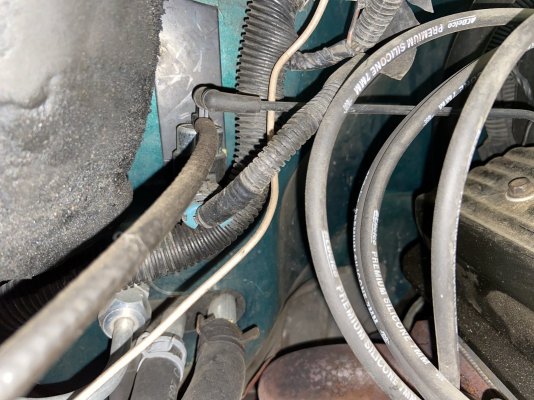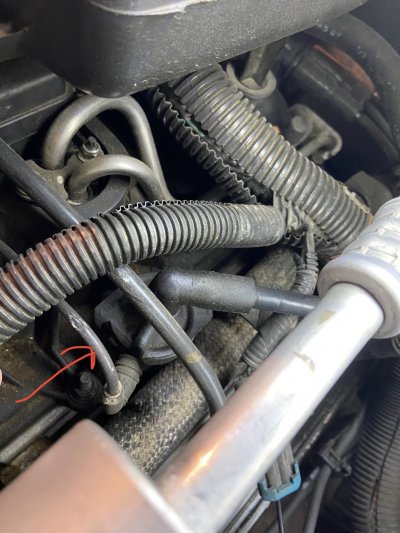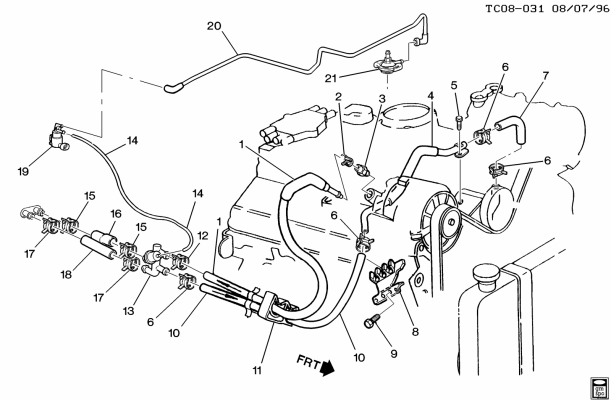You are using an out of date browser. It may not display this or other websites correctly.
You should upgrade or use an alternative browser.
You should upgrade or use an alternative browser.
1998 yukon Mystery p0300 and rough idle still
- Thread starter OilBurner2003
- Start date
Disclaimer: Links on this page pointing to Amazon, eBay and other sites may include affiliate code. If you click them and make a purchase, we may earn a small commission.
OilBurner2003
Full Access Member
- Joined
- Jul 24, 2022
- Posts
- 280
- Reaction score
- 170
Like the Oil fill cap? Should one plug that with something? I figured it being on would be enough. I’m probably wrong about that.
OilBurner2003
Full Access Member
- Joined
- Jul 24, 2022
- Posts
- 280
- Reaction score
- 170
I did not scan it, and yeah, I’m a little nervous about taking it all apart. Damn things so old I’m worried I’ll snap a ground trying to take the wires off.Did you scan it when plugged? Generally if no fuel trim or other changes noted, then lower gaskets a definate leak. Should take you about 4.5 hours depending.
east302
Full Access Member
Yeah, I’m having a complete brain fart - must be that time of day.
Never done the test but was trying to visualize the whole process of air being drawn out of the lifter valley through the intake and what you’d see at the dipstick. Would you just as easily see vacuum at an open PCV hole (or open oil cap) if the dipstick were plugged and the intake is leaking?
Been a long day, probably should quit typing, lol.
Never done the test but was trying to visualize the whole process of air being drawn out of the lifter valley through the intake and what you’d see at the dipstick. Would you just as easily see vacuum at an open PCV hole (or open oil cap) if the dipstick were plugged and the intake is leaking?
Been a long day, probably should quit typing, lol.
OilBurner2003
Full Access Member
- Joined
- Jul 24, 2022
- Posts
- 280
- Reaction score
- 170
Haha no worries dude, I’m gonna start on the intake tomorrow! Whether I finish it within a week no one knows, I’m gonna do some research and I’ll probably have questions for you fine gentleman if I get stuck with something.Yeah, I’m having a complete brain fart - must be that time of day.
Never done the test but was trying to visualize the whole process of air being drawn out of the lifter valley through the intake and what you’d see at the dipstick. Would you just as easily see vacuum at an open PCV hole (or open oil cap) if the dipstick were plugged and the intake is leaking?
Been a long day, probably should quit typing, lol.
Be very careful disconnecting Q/D heater hose at intake manifold. Cast zinc very weak/corrodes quickly/easily. if it breaks, use a small chisel about screwdriver size and bend remaining threaded portion towards center of hole. Eventually you will break a chunk out and can continue removing until either you can grab it with needlenose or like a 90 icepick to pop pieces out and clean threads. Good Luck!
Replacement part about $15.
Replacement part about $15.
OilBurner2003
Full Access Member
- Joined
- Jul 24, 2022
- Posts
- 280
- Reaction score
- 170
I will do my absolute best to not break it!Be very careful disconnecting Q/D heater hose at intake manifold. Cast zinc very weak/corrodes quickly/easily. if it breaks, use a small chisel about screwdriver size and bend remaining threaded portion towards center of hole. Eventually you will break a chunk out and can continue removing until either you can grab it with needlenose or like a 90 icepick to pop pieces out and clean threads. Good Luck!
Replacement part about $15.
OilBurner2003
Full Access Member
- Joined
- Jul 24, 2022
- Posts
- 280
- Reaction score
- 170
Hey, I think I found something really important. Something didn't show up on the smoke test. This is what looks like some kind of vacuum booster? While I was getting ready to rip off the intake, removed the air box and I saw this. As soon as I touched it it fell off. I got to thinking and was wondering if it was a vacuum line, started the engine and put my thumb on the end of the line, sure enough it's a vacuum of some sort. I'm not even sure what this is, but the other end of it runs into the firewall, kind of hard to see back there. So before I do this 6 hour job...What are your guy's opinion on this? Both sides of the line are cracked and basically crumbling apart. Not even sure if it's related, But we had a long talk about unmetered air and vacuum lol.Yeah, I’m having a complete brain fart - must be that time of day.
Never done the test but was trying to visualize the whole process of air being drawn out of the lifter valley through the intake and what you’d see at the dipstick. Would you just as easily see vacuum at an open PCV hole (or open oil cap) if the dipstick were plugged and the intake is leaking?
Been a long day, probably should quit typing, lol.
Attachments
east302
Full Access Member
Your picture shows the heater water valve. The vacuum line goes to a solenoid on the firewall which has another vacuum line (hard plastic) that goes across the intake to the PCV valve fitting.
When the “MAX” detent is selected on the a/c temperature dial, the solenoid is energized and vacuum is applied to the water valve. That closes the valve, shutting off coolant to the heater core and maximizing a/c performance.
Yes, it needs to be either fixed or just cap the line at the PCV fitting.



When the “MAX” detent is selected on the a/c temperature dial, the solenoid is energized and vacuum is applied to the water valve. That closes the valve, shutting off coolant to the heater core and maximizing a/c performance.
Yes, it needs to be either fixed or just cap the line at the PCV fitting.



OilBurner2003
Full Access Member
- Joined
- Jul 24, 2022
- Posts
- 280
- Reaction score
- 170
Roger, thank you. I couldn’t find that information anywhere! Back to intake disassembly!Your picture shows the heater water valve. The vacuum line goes to a solenoid on the firewall which has another vacuum line (hard plastic) that goes across the intake to the PCV valve fitting.
When the “MAX” detent is selected on the a/c temperature dial, the solenoid is energized and vacuum is applied to the water valve. That closes the valve, shutting off coolant to the heater core and maximizing a/c performance.
Yes, it needs to be either fixed or just cap the line at the PCV fitting.
View attachment 387616
View attachment 387617
Similar threads
- Replies
- 7
- Views
- 386

